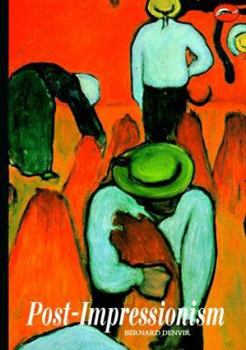Post-Impressionism
(Part of the World of Art Series)
What happened after Impressionism? What did it lead to? From Seurat's's Pointillism in the 1880s to the expressive use of color by the Fauves in the early 1900s, to Post-Impressionist artists--... This description may be from another edition of this product.
Format:Paperback
Language:English
ISBN:0500202559
ISBN13:9780500202555
Release Date:December 1999
Publisher:Thames & Hudson
Length:216 Pages
Weight:1.05 lbs.
Dimensions:0.6" x 5.9" x 8.3"
Customer Reviews
2 ratings
A serviceable survey of an era that is difficult to sum up
Published by Thriftbooks.com User , 21 years ago
As Bernard Denvir points out in this excellent survey, there really isn't Post-Impressionism as such. Denvir explains that only in the English-speaking world does the expression even exist. Indeed, there clearly is no defined school or movement to which the term Post-Impressionism refers. Instead, it vaguely points at all the painters and artists--whether individuals or schools--that reacted to the work of the Impressionists. As Denvir points out, there are two broad ways in which the so-called Post-Impressionists could and did react to the Impressionists. One of these ways is varying with the Impressionists in Form, such as much of the work of painters like Seurat and his followers, Cézanne, Gaugin, and Van Gogh. This part of the book is by far the most familiar to the casual art student or museumgoer. But Denvir also covers those various painters who differed over issues surrounding Content. Denvir shows how many, many painters were off put by the lack of historical or symbolic content to be found in the work of the Impressionists. In the end, the reader will primarily gain an impression of how enormously diverse and changing the art world was in the wake of Impressionism. We tend to prefer our histories to be nice and neat and unmessy, but these were messy times, and Denvir does an excellent job of reflecting that disorder. The book ends with a helpful listing of many of the key figures from the period. Overall, I would not say this is one of the very best book in the World of Art series, but it is nonetheless a very helpful one.
They rock our art
Published by Thriftbooks.com User , 23 years ago
English critics Roger Fry and Desmond Mac Carthy came up with the word post-Impressionist to describe paintings by French modern artists for a showing at the Grafton Galleries in 1910. The term took in what came after Georges Seurat's "Une baignade a Asnieres," with its unspontaneous need for many preliminary studies, and "La grande jatte," with all its tiny round dots, ended the dominating outdoors, small-brushstroked, spontaneous style of Impressionism. Post-Impressionism took shape with Paul Cezanne's emotional art leaving out realities of atmosphere, light and shade in "The large bather" and "Still life with onions and a bottle"; Pierre Cecile Puvis de Chavannes's keeping going the Classical tradition of appeal to noble emotions, harmony in composition, and stability with subdued colors in "The sacred grove"; Odilon Redon's Hieronymus Bosch- and Pieter Bruegel-like irrationally unreal imagery leading into Surrealism, as in his "Origins" album, with a central eye in his flower drawing; Douanier Rousseau's primitive art, with his tigers Cezanne- and Claude Monet-like in their horizonless and skyless clearings, Paul Gauguin-like in their nostalgia for a lost paradise, proto-Pablo Picasso in their enchantingly mixed fantasy with reality, and Georges Seurat-like in their large-scale stillness; and Vincent Van Gogh's "Night cafe" becoming the most persuasive example of the Romantic abstract, unrealistic use of color. Post-Impressionism spread with the forming of artist-friendly galleries and organizations for showing works, such as the Societe des artistes independants; the avant-garde Les vingt, with such Pointillism practicing members as James Ensor and Alfred William Finch; Societe nationale des beaux-arts, for such decorative artists as Carolus-Duran and John Singer Sargent; and the Salon d'automne, with its striking showing of Henri Matisse's "Woman with a hat," proto-Fauvist in Cezanne-type solidity and violent colors. Post-Impressionism also spread with Japanese print- and Henri Toulouse-Lautrec poster-influenced compositions, proto-abstract art in their flat colored structure, such as the albums, book illustrations, posters, prints and theatre programs by Pierre Bonnard and Edouard Vuillard; with commercially successful printmaking, such as Felix Bracquemond's Societe des peintres-graveur album of individual artist prints and yearly exhibitions, Theatre d'art and Theatre de l'oeuvre founding actor manager Aurelien Lugne-Poe's commissioned posters, programs and stage designs from the Nabis, and Lucien Pissarro's Eragny Press booklets illustrated with colored engravings; and with close links to twentieth-century events and ideologies, such as Pablo Picasso's Spanish Civil War-based "Guernica." Author Bernard Denvir's appropriately illustrated and well-organized book reads particularly well with Florence E Coman's TREASURES OF IMPRESSIONISM AND POST-IMPRESSIONISM, Fogg Art Museum's IMPRESSIONIST AND POST-IMPRESSIONIST PAINTINGS, Sarah Halliwel






